For artist Richard Small, a.k.a Raven Richie, the mountains and wildlife of his home in British Columbia serve as inspiration across mediums. From his birthplace in Fernie, nestled in the Kootenay Mountains, to his current home in coastal Whistler, he capitalizes on his eclectic interest—from drawing and digital work to cocktail making—he pushes his artistic boundaries. We caught up with him to learn about how he brings together his varied pursuits with his love for the natural world. Here’s what he had to say.
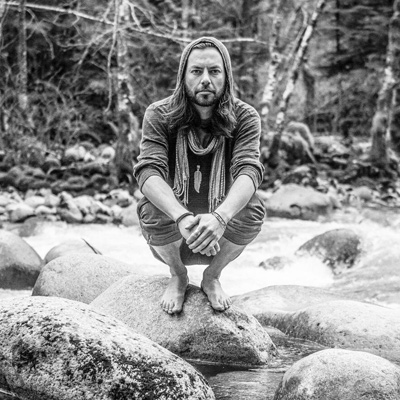
Richard Small in his element. [Photo] Grace Dove
Backcountry Magazine: What got you started in art?
Richard Small: In 2003, I moved away from Fernie to go to art school in Nelson, B.C., where I did a three-year metalworking program at a private art school. I stayed in Nelson for 10 years because of the skiing—primarily the backcountry skiing around Whitewater, and after that, I spent a few seasons in Revelstoke and competed on the Freeride World Tour around the globe. I now live on the west coast with my amazing girl and am within walking distance to the chairlift, so life is good.
I started doodling a lot in high school; I always loved art class. When I was 17 or 18 years old, I got a job at the Island Lake Lodge cat skiing operation. Originally, I wanted to be a backcountry ski guide, and my dad told me that if I got a job at Island Lake Lodge doing anything—picking up rocks on the road, doing the dishes, just getting a foot in the door—that would be a good start for me. So I got a job doing dishes, and within my first season of cat skiing a few times during staff days, I quickly realized that ski guides were, in a way, glorified mountain babysitters.

Title: Mist and Molecules
That was a big eye-opener for me, but I was having a lot of fun working in the kitchen with high-end chefs and other artistic types, and I realized the artist path was what interested me.
Prep cooking and plating deserts there gave me an outlet for my creativity. I also used to design the chalkboard inside the lodge, because every night the menu would be different. While I was there, a coworker named Sandra told me about an art school in Nelson I might be interested in called Kootenay School for the Arts. She knew that with my half First Nations heritage I had the opportunity to go to school for free. She was the one who put the idea of art school in my head. And, of course, I still proudly wave that native flag too, as half my blood is from way up north near Smithers—my mother is from the Wet’suwet’en Nation of the Northwest Coast.
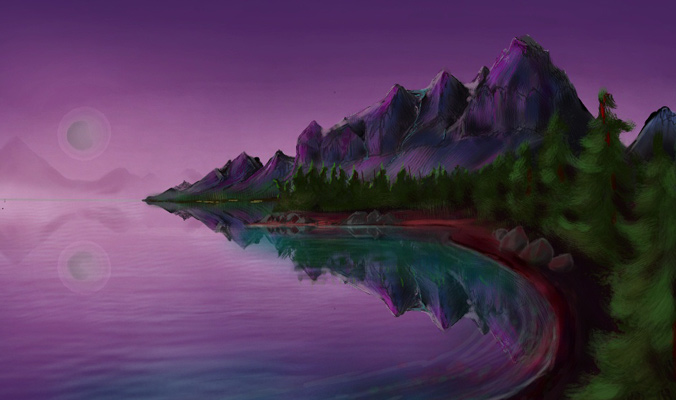
Title: Indica Lake
BCM: What was art school like for you?
RS: After Island Lake Lodge, I moved to Nelson for school. I took metal work and clay, and at first I thought I would continue with clay because it came naturally to me, but I was totally blown away by what you could do with metal, so I disappointed my pottery teacher and focused on metalwork. That medium is something I’ve always wanted to go back to, but being a ski bum and getting into big mountain skiing competitions; it’s hard to develop that kind of studio. You need a backyard and you need a shop. So unfortunately after school I never did metalwork, but school opened my eyes to all the other things I could do with illustration, sculpture, interior design and everything on the business side of artwork that I learned there.
Ever since then I’ve done many kinds of artwork. My father and I were always avid woodworkers, so I’ve always been pretty comfortable with that. I got into a bit of leatherwork; I make jewelry, I play music, I paint, I design tattoos and logos, the list goes on—I really have many interests. I’ve never really become a master at any one thing; I’m always bouncing around.

Title: The Creator
BCM: What’s your skiing background?
RS: I started competing in amateur big mountain competitions when I was going to school in Nelson. I really pushed my professional ski career, and I wanted to get on the Freeride World Tour, so I worked at it and ended up competing professionally on that tour for five years after qualifying. I definitely lived a dream. Now that I’m in my 30s, I have stepped back from the stressful competitions and am focusing on my artwork a little bit more, but I still feel I have some good years of competition in me, and I’d like to make a return to better satisfy my own selfish glory.
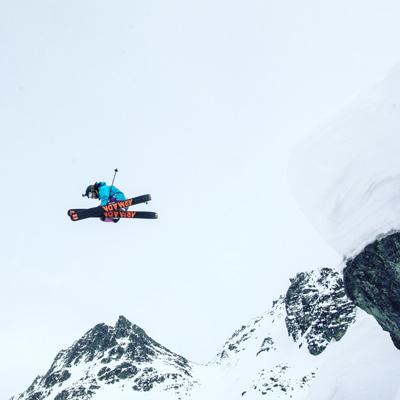
Raven Richie showcasing his ski style. [Photo] Grace Dove
RS: My native heritage has always given me a deep sense of connection with my natural surroundings, especially in the backcountry, and as a skier, a raven symbolizes the spirits of people who have lost their lives in the mountains. I have always loved that idea, and it really resonates with me as something that you would hear in Native American culture. Then in my northwest coast culture, the raven symbolizes the trickster and one who can transform into other states of being, and in our old stories, he also put the sun, the moon and all the stars in the sky, so my two worlds are brought together by this animal—my “spirit animal” if you will. Hence my nickname, Raven Richie.

Title: Every Adventure Requires a First Step
I think about how, if my great grandfathers and grandmothers could see the way I am able to travel in the mountains and ski, they would be astounded by the beauty of what skiing allows me to achieve—in terms of connecting with my natural surroundings and the flight of skiing itself. I often think of skiing in these mythical ways and just how damn awesome it is.
BCM: What does your artistic process look like?
RS: I’m not sure I really have a process, because I’m interested in so many different mediums. I can be a bit scatter-brained, but when it comes to painting an animal or a landscape, I think it’s a lot like climbing a mountain and skiing down it. I was thinking about this the other day—if you have an idea of where you want to go, you can see the possibilities, the potential objectives. But once you start moving, you start to see things in different ways, and pretty soon, you have an end goal in your vision, but at the same time, you’re just along for the ride. So with my artwork, I have a basic idea of what I want, but when I get going, it evolves naturally.
BCM: How would you describe your style?
RS: With my drawing, I have different styles. I do fluid mountain scenes and I do more traditional native form artwork, but I was never trained to do native artwork—it’s all self taught, so I don’t see myself as a traditional native artist. I see myself as a contemporary native artist, because I don’t follow the rules that you may read about when it comes to designing totem poles and crests. I respect those rules and those traditional ways, but I believe that if we keep doing things the same way and we keep telling the same stories, our culture is at risk of creative stagnation. Just because I am a part of the native culture doesn’t mean I am locked into doing traditional native artwork; I try to avoid feeling stale with my work.
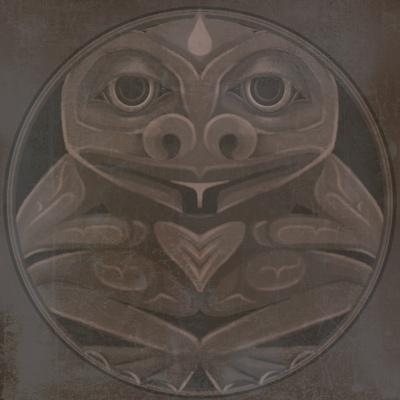
Title: Laksilyu
BCM: What’s on the artistic horizon for you?
RS: Right now my focus—besides my paintings—is cocktails. I have been cocktail bartending for three or four years now, and you can find me running the cocktail program at the Four Seasons here in Whistler. I’ve also been doing mixology competitions and using my creative eye in a different sort of way; I’ve even won a few.
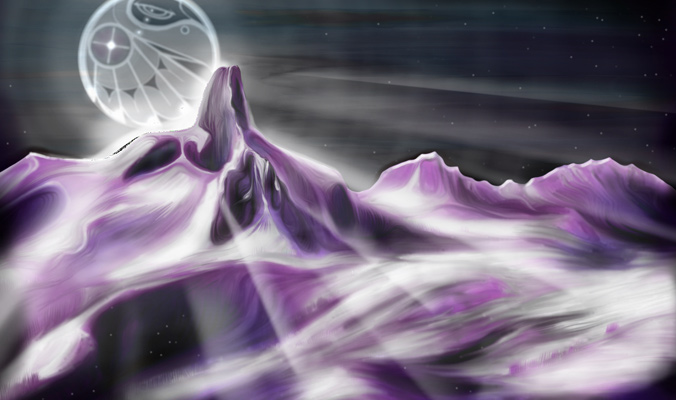
Title: A White Raven over the Black Tusk
Currently I’m working toward being able to represent Canada on a national level to go to the world-class bartending championships. I think it’s hilarious that I was competing on the Freeride World Tour a few years ago and now I am trying to get into one of the biggest mixology contests in the world. I just shake my head sometimes when I think about where my life has taken me. I still have so many more ideas to pursue and feel honored that people take interest in my work. Watching people get blown away by my paintings or a fancy cocktail is immensely rewarding for me. It’s just all that love of my life and the mountains pouring through my hands and I’m grateful to be able to create. So who knows what’s up that next mountain for me? I just have to keep climbing I guess.
—
To learn more about Small’s art, visit www.ravenrichiearts.com.








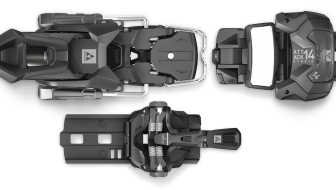

Related posts:
Skintrack Sketches: Freeskier Chris Benchetler tops things off with graphic design
Skintrack Sketches: How Eric Pollard balances art and professional skiing
Skintrack Sketches: Vermont artist Jess Graham speaks to her love of lines in painting and snowboard…
Skintrack Sketches: John Fellows carves a place for his recreation-inspired artwork